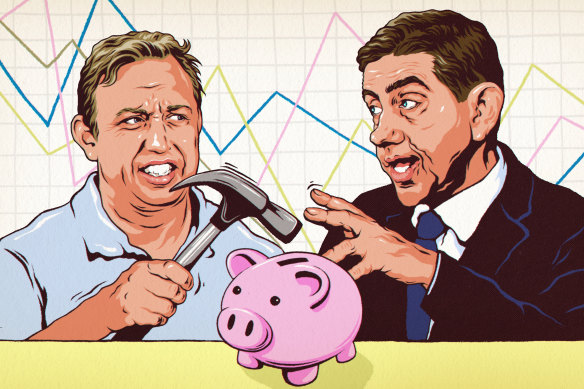This was published 1 year ago
Qld to spend $11b on cost-of-living, inflation help as it looks for savings
By Matt Dennien
The Queensland government will deliver $11.2 billion in help for households in the year ahead to ease living costs and inflation, as it boosts infrastructure spending and leans into higher-than-expected population growth to help get it back to a budget surplus.
As record coal royalties return to normal, Treasurer Cameron Dick’s fifth budget, handed down on Tuesday, has laid out a new almost $4 billion internal savings effort, along with a tax and debt enforcement drive, over the next four years.

“Queenslanders will be asked to make a choice about their future,” Cameron Dick will say in his budget speech.Credit: Nordacious (aka James Hillier)
And with little more than four months to Labor’s first election under Premier Steven Miles, Dick has sought to position the 2024-25 budget as a political fresh slate.
“Queenslanders will be asked to make a choice about their future, not to express an opinion about the past,” Dick told parliament in his speech, daring the LNP to reject tax increases for some foreign property owners and miner Glencore, and to outline its own plans.
After weeks of drip-fed budget details overwhelmingly focused on cost-of-living relief, the final measure announced by the government was a freezing of all government fees and charges for the coming financial year, at a cost of $180 million.
This, combined with previously announced measures, will allow Dick and Labor to spruik “nation-leading” cost-of-living support that Treasury expects will also shave 1.25 percentage points off Brisbane’s inflation growth for the year, to 2 per cent.
It is also coupled with a $20 billion lift to the government’s infrastructure pipeline over four years, and an 11 per cent, $4.3 billion boost to the health budget, which is inching towards one-third of the state’s $90 billion expenses tab.
This amid a “population explosion we did not anticipate”, as Dick described it to journalists before releasing the budget, which notes a 2022-23 population increase 60 per cent higher than expected meant “tens of thousands more people who need somewhere to call home”.
While falling coal prices will leave a $4.3 billion revenue hole next financial year, this will be partially offset by a $2.1 billion lift in tax revenue thanks to strong workforce figures and related payroll tax, along with stamp duty through high property prices.
All three have helped turn an expected $2.2 billion deficit for 2023-24 into a modest surplus of $564 million – the third consecutive budget in which revenue has outweighed costs, but a far cry from the record $12 billion boasted in 2022-23.
The state expects to run a $2.6 billion deficit in the 2024-25 financial year, and a $515 million one in 2025-26, before returning to surplus thanks to a “smarter spending taskforce” to drive $3 billion worth of savings over four years – without job losses.
The Queensland Revenue Office will also get extra funding to bring in $970 million more from tax enforcement and debt recovery over the same period.
By then, net debt – the government’s preferred measure, which excludes state-owned corporations – is now expected to be $13 billion lower than previously forecast, at $60 billion. Total debt is also expected to come in slightly lower than forecast, at $172 billion.